|
|
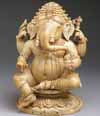 |
==Met
Museum timeline: *South
Asia, 1400-1600* |
 |
==The
Delhi Sultanate in decline: After the weak Sayyids (r.1414-48)
virtually lose interest in ruling, the Lodhis (r.1451-1526) try their best
to pull it together-- but fate is against them, and Babur is waiting in
the wings. (*Routes*) |
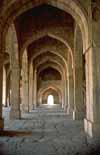 |
==Mandu
(1405-34): After Timur's sack of Delhi in 1398, the Delhi Sultanate governor
of Malwa declares his independence in 1401. After his death his son, Hoshang
Shah (1405-34), shifts the capital to Mandu, and creates there some of
the triumphs of Sultanate-period architecture. Discussion: *Imperial
Gazetteer 2:185*; *India
Nest*. Images: *architectural
views*; also *Berger*:
scroll down in the left-hand frame to "Madhya Pradesh" and "Mandu" (one
set for each of seven buildings). (*Routes*) |
 |
==Ahmedabad
too acquires some magnificent architecture, as the decline of the Delhi
Sultanate makes it possible for Gujarat and other regional kingdoms, like
that of the Sharqis in Jaunpur, to develop. Discussion and images: a good
*overview
site*. (*Routes*) |
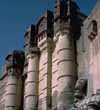 |
==Jodhpur
and other Rajput forts (c.1459): "Rao Jodha, the maharaja
of Marwar, founds Jodhpur. He builds a large hill fort and sets the pattern
for Rajput states" (--Met).
Like most such Rajput hill fortresses, this one was added to for the next
several centuries, so that the buildings in it are of markedly different
periods. Many other medieval Rajasthani forts, some gorgeous: *Berger*
(scroll down in the left-hand frame to "Rajasthan"). Discussion: *art
and archaeology*; *India
Nest*. On the Rajputs: *Imperial
Gazetteer*. (*Routes*) |
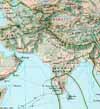 |
==the
Muslim world has adjusted to the new Mongol dynasties-- geographically
and politically speaking, at least. By the 1480's, the Ottoman Empire is
starting to take shape (*Univ.
of Texas*). And it has its own magnificent art (*Met*). |
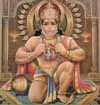 |
==the
Bhakti movement sweeps the north: During this century and
the next, the bhakti movement comes into full flower in the whole of the
north (*Sources
of Indian Tradition*). Its cultural, literary, and artistic effects
are incalculable, and continue into the present. (*Routes*) |
 |
==Kabir
(1440?-1518?),
the consummate poet of "nirgun bhakti" (worship of a God without form or
features), is traditionally placed in this century. He is identified as
a weaver by trade, and is famous for rejecting both formal Hinduism and
formal Islam, and for seeking in his rough, colloquial poetry a path outside
or beyond them. Poems attributed to him exist in a variety of dialectical
forms; some are included in the Guru Granth Sahib. Kabir sources: *Columbia
Univ.*. (*Routes*) |
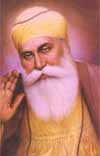 |
==Guru
Nanak (1469-1539), the founder of Sikhism, is also a great
devotee of a "nirgun" God, and seeks a religious path that avoids the formal
structures of both Islam and Hinduism. Shortly before the end of the century
he attains full realization of the path he is to take, and begins to teach
and to acquire followers. His poems, often sung, are the heart of the later
Guru Granth Sahib. More on him and on Sikhism: *Sources
of Indian Tradition*. |
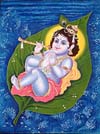 |
==Surdas
and Krishna-bhakti (1479?-1581?). Another famous bhakti saint-poet
traditionally placed in this century, Surdas is a preeminent practitioner
of "sagun bhakti," the worship of a God with form and qualities. In his
case, his preferred form of God is the child Krishna; his poems are greatly
loved, and new ones are constantly attributed to him. Thus his collected
work, the Sursagar, grows bigger with every edition. Many verses of his
appear in the Guru Granth Sahib (for example, *sacred
texts*, parts 12-15). (*Routes*) |
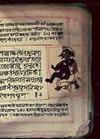 |
==Chaitanya
and Bengali Vaishnavism: The distinctively Bengali "Gaudiya
sampraday" school of Krishna-bhakti takes shape under the influence of
Shri Krishna Chaitanya (1486?-1534?) (*John
Beames*), thought by his followers to be an incarnation of Krishna
himself. Chaitanya incorporates the verses of Jayadeva (*Black
Peacock*), and of his own slightly earlier Bengali contemporaries Chandidas
(1417?-78?) (*sacred-texts*)
and Bidyapati (1433?-81?) (*John
Beames*), into a theology based on rapt contemplation of the love of
Radha and Krishna (*British
Museum*). |
 |
==the
Hatha-yoga-pradipika (1400's) by Svatmarama: an influential
handbook about a traditional meditative body-and-mind discipline, composed
by an author about whom little is known. Available in a translation by
*Brian Dana
Akers*. A modern discussion of the discipline: *hatha
yoga*. A good academic overview: *Theory
And Practice of Yoga (2005)*. |
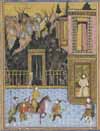 |
==the
Bahmanids break apart (c.1490 on): The governors of the four
provinces of the Bahmanid sultanate in the Deccan break away, resulting
in the formation of five smaller Deccani sultanates: *Ahmadnagar*,
*Berar*,
*Bidar*
(their former capital city), *Bijapur*,
and *Golconda*.
The rulers of Bijapur, in particular, become great patrons of the arts:
*Met*.
Discussion: *Ikram
Ch. 6*. (*Routes*) |
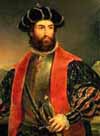 |
==Vasco
da Gama arrives (1498) in Calicut, on the Malabar Coast:
from then on, the Portuguese begin to visit the western coast of India,
and gradually manage to establish trading posts and forts at Goa and elsewhere.
Vasco da Gama himself (*British
Library*; *Maritime
Museum*; *Univ.
of Michigan*) offers his own account of his first journey to India:
*Internet
Sourcebook*. A more detailed report: *Hernan
Lopez de Castaneda*. (*Routes*) |
|
|















